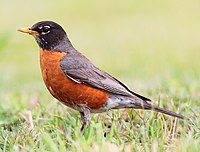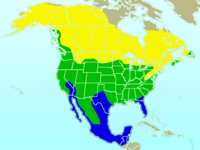
Back Turdus migratorius AN سمنة أمريكي شمالي Arabic سمنه امريكى شمالى ARZ Turdus migratorius AST Pipatciw ATJ Gəzərgi qaratoyuq Azerbaijani Ръждивогуш дрозд Bulgarian Moualc'h-Amerika Breton Griva americana Catalan Turdus migratorius CEB
| American robin | |
|---|---|

| |
| Adult | |
| Scientific classification | |
| Kingdom: | |
| Class: | |
| Order: | |
| Family: | |
| Genus: | |
| Binomial name | |
| Turdus migratorius Linnaeus, 1766
"in America septentrionali" | |

| |
Breeding range Year-round range Wintering range
| |
The American robin (Turdus migratorius) is a migratory songbird. Also known as the North American robin,[2] it belongs in the thrush family, Turdidae. It was named after the European robin. This is because the European robin has a bright orange-red face and breast. The two species are not closely related.[3] The American robin has seven subspecies. T. m. confinis is the most different subspecies.[4]
The American robin lives throughout North America. It is a rare vagrant to western Europe (a vagrant is a bird that is found outside its normal species' range). It has also been a vagrant to Greenland, Jamaica, Hispaniola, Puerto Rico, and Belize.[4] The American robin can be found in many different kinds of habitats.[5] It likes open areas of ground to feed and areas with trees or shrubs to breed and sleep.[6] Because it has a large range, the IUCN Red List says that the American robin will not decline, and is listed as of least concern.[1]
The American robin begins to breed shortly after returning to northern North America after spending the winter in the south.[6] The female will choose where to build the nest. She will make the nest with grass, sticks, paper, feathers, rootlets, and moss. Once the nest is built, she will lay 3 to 5 eggs.[5] After the chicks leave the nest, both parents will continue to take care of them, until they can live on their own.[6]
American robin eggs and juveniles are eaten by squirrels, snakes, blue jays, common grackles, American crows, and common ravens. The adults are eaten by hawks, cats, and larger snakes.[6] Sometimes, the brown-headed cowbird lays its eggs in the Robin's nest. This is called brood parasitism. However, the robin usually rejects the cowbird eggs.[7]
- ↑ 1.0 1.1 BirdLife International (2004). Turdus migratorius. 2006 IUCN Red List of Threatened Species. IUCN 2006. Retrieved on 12 May 2006. Database entry includes justification for why this species is of least concern
- ↑ Manwell, Reginald D.; Sessler, Gloria J. (1973), "Blood Parasites of Pekin Robins (Liothrix luteus)", Journal of Eukaryotic Microbiology, 20 (3), Syracuse: Department of Biology, Syracuse University: 363–364, doi:10.1111/j.1550-7408.1973.tb00900.x, PMID 4199914[permanent dead link]
- ↑ McCrum, Robert; William Cran, Robert MacNeil (1992). The Story of English. Faber and Faber. p. 123. ISBN 0-571-16443-9.
- ↑ 4.0 4.1 Cite error: The named reference
Clementwas used but no text was provided for refs named (see the help page). - ↑ 5.0 5.1 Cite error: The named reference
Cornellwas used but no text was provided for refs named (see the help page). - ↑ 6.0 6.1 6.2 6.3 Cite error: The named reference
ADWwas used but no text was provided for refs named (see the help page). - ↑ Wolfe, Donald H. (December 1994), "Brown-headed Cowbirds fledged from barn swallow and American robin nests", The Wilson Bulletin, 106 (4): 764–766
© MMXXIII Rich X Search. We shall prevail. All rights reserved. Rich X Search
